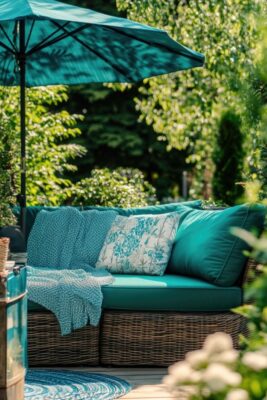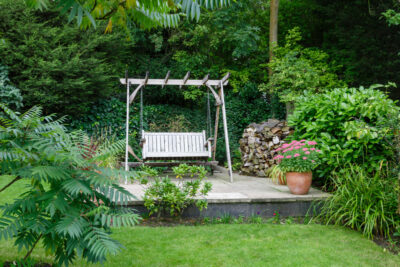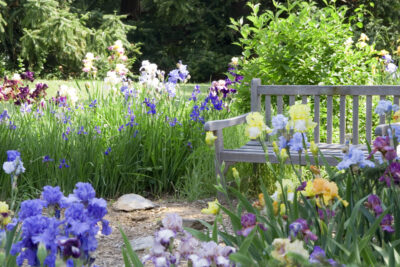
What will our gardens look like this year? In 2025, green industry experts see a trend toward making our piece of the great outdoors friendlier to birds and easier on the planet. People are increasingly keen to create green spaces for stress-relief and finding calm. And we want lived-in authenticity and a reason to get off social media. Here are the major garden trends you can expect to see this growing season, along with expert tips on trying them yourself.
 1. Teal and Bold Colors
1. Teal and Bold Colors
We want bright colors in our lives again, including our gardens. So much so that Garden Media Group (GMG), a public relations company serving the nursery industry, has named teal its 2025 Color of the Year. “[Teal] evokes a powerful sense of nostalgia for the vibrant and carefree spirit of the 1990s and early 2000s, a time of bold fashion and optimistic energy,” GMG says in its most recent Garden Trends Report.
Along that vein, Monrovia is seeing increased interest in plants with blooms in bright, bold colors, says Katie Tamony, chief marketing officer for the plant company. “People are super-interested in intensely colored hydrangeas, the bluer the better. We’re seeing interest in deep, deep reds and bright, bright pinks, and a lot of interest in orange,” she says.
This trend for bright colors is most popular among Gen Z and Millennials. “This population is yearning for an era we think of as a happy time,” says Tamony. “They seem to want to remind themselves of that feeling we had when they were children.” Monrovia found that 36% of homeowners said gardening reminded them of simpler times and made them feel nostalgic, so incorporating vibrant colors into their gardens makes sense for people of a certain age.
Bring teal into your garden with furniture, deco pots, and teal-hued plants, such as blue chalk sticks (Senecio mandraliscae), Blue Weber agave (Agave tequiliana), and blue fescue grass.
 2. Green Drenching
2. Green Drenching
Numerous studies have shown that natural environments full of plants increase positive emotions and decrease negative ones. Green drenching is a technique for creating an area where the soul-soothing power of plants invites a deeper connection to nature and creates a sense of inner calm.
“We are desiring living spaces that are calming and have a feeling of serenity,” Tamony says.
Green drenching is based on the design trend of color drenching, which involves creating a living space with a monochromatic color scheme to reduce visual noise. In green drenching, you use plant leaves to create a wall of green hues indoors or outdoors.
To green-drench a living space, try filling a wall of shelves with trailing and hanging houseplants; plant a living hedge to create privacy; or make a privacy screen on a patio with containers full of oversized green plants. Use plants with leaves in shades of green and various textures to keep the monochromatic color scheme lively. You can green-drench a patio, yard, sunroom, or bedroom.
“You want a feeling of going on a little mini escape,” Tamony says of the philosophy behind green drenching. Think of green drenching as self-care administered with leaves.
3. IRL Antidote
Gardens are emerging as an IRL antidote to online living akin to the gamer concept of “touching grass” to combat screen fatigue. All the years on social media platforms have left us weary of the digital world and craving something more tangible. Perhaps that’s why management consulting company Gartner has predicted that 50% of consumers will spend less time on social media in 2025. Garden Media Group’s trend report also predicts that people will be spending less time on digital interactions and more time on human and natural connections.
Enter plants and gardens. They can get us off our screens and outside, with our hands in the dirt instead of on a keyboard. In 2025, we can find our tribe at community gardens, plant swaps, and if we really must have some screen time, we can spend it in online groups dedicated to plants, gardens, and people who love them.
If your phone’s weekly report of your screen time is concerning, it’s time to put down your phone and pick up a trowel, a sack of potting soil, and a plant or seeds. Green-drench a space to enjoy with family or friends. Plant a garden of teal plants and find your balance.
4. Living Fences
About 30%—around 75 million of us—live in communities governed by an HOA. Because of this, we crave ways to add some personality to our property without breaking HOA rules. Living fences are a good way to differentiate a property while adding elegance and privacy. Hedges are the most predictable ways to create a living fence, but try a mix of plants for a diverse hedge that will support wildlife and make a living fence into an ecosystem. Living fences reduce soil erosion and stormwater runoff, while softening your house more than wood or steel fences.
Living fences cost less than a privacy fence, too. A privacy fence can cost an average of $50 a foot, adding up to $2,500 for a 50-foot section. A living fence that’s 50 feet long costs between $300 and $500, depending on the plants you choose.
 5. Hummingbird Fever
5. Hummingbird Fever
Hummingbirds are this year’s glamor animal, according to Tamony. Like penguins, dolphins, and whales, people feel a strong connection to them. “Hummingbirds are becoming incredibly popular for gardeners, and everyone wants to draw them to their garden,” she says.
Sadly, hummingbird populations are in decline due to factors such as habitat loss and climate change. Help these tiny pollinators out by planting lots of colorful, tube-shaped flowers that produce the nectar hummers love to eat and putting out hummingbird feeders. You get a connection to nature, which will make you feel better, and hummers get food and habitat.
 6. Deliberately Messy Gardens
6. Deliberately Messy Gardens
A manicured lawn of turf grass and beds full of pesticide-treated ornamentals is about as opposite from nature as you can get. As a result, bird and insect populations have dwindled alarmingly, and the air and water quality have suffered. Perhaps that’s why more and more gardeners want their outdoors spaces to be purposefully imperfect.
Monrovia surveyed homeowners and found that 28% wanted their garden to have a more natural look, up 6% from the previous year. For both ourselves and the planet, it’s time to adopt a more relaxed and earth-friendly gardening style. Katie Dubow of GMG calls this look “lived-in gardens” and says we’ll see more of it as people reject pristine, symmetrical landscapes that fight against nature every step of the way.
Try one or more of these ideas to get that lived-in, natural look for your outdoor space:
- Replace thirsty turf grass with an alternative, such as a meadow, pollinator garden, native plant garden, or outdoor living area.
- Let the grass grow longer between mowings and leave the clover in the lawn.
- Leave spent flowers on stalks so birds can eat the seeds and find shelter.
- Allow vines to climb to unexpected areas and create dense plantings that make a yard look established. A little strategic pruning helps keep the look intentional rather than unkempt.
- Choose native perennials, shrubs, and trees that will thrive in your climate and support local wildlife.
- Let moss grow on walls, rocks, and tree trunks, where it won’t cause any harm.
Leanne Potts, Better Homes & Gardens

